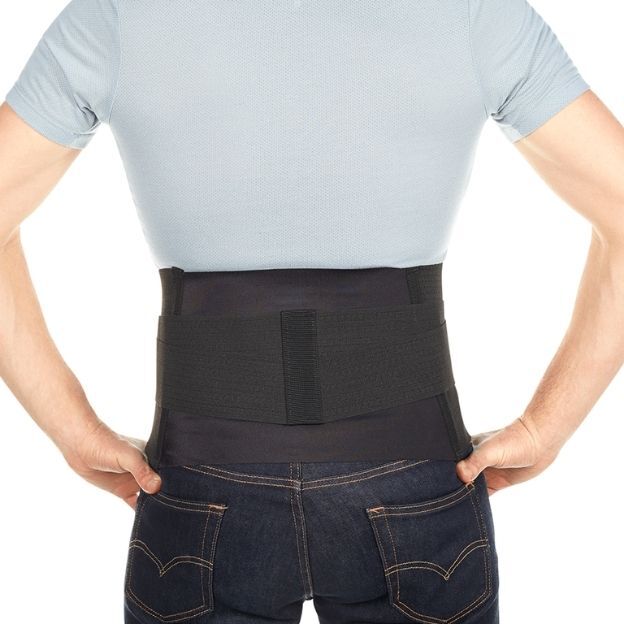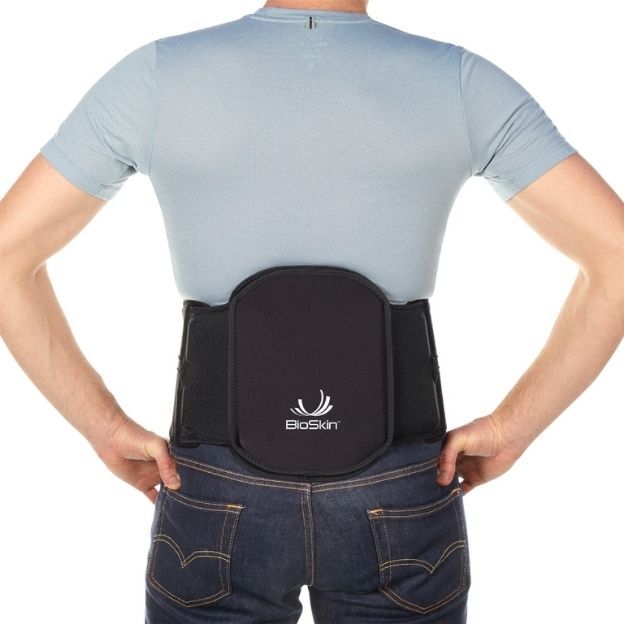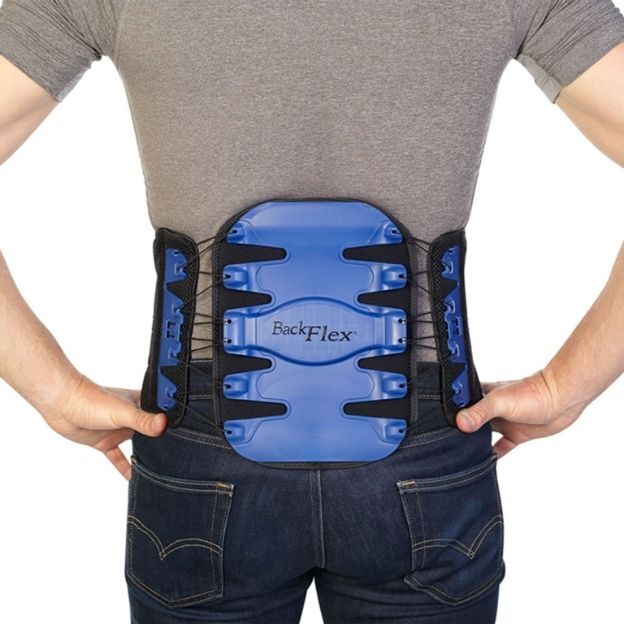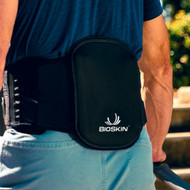When people search for the best back brace for pain relief, it’s important to set realistic expectations. A brace can provide support, reduce strain, and make daily movement more comfortable, but it isn’t a cure or a stand-alone treatment.
The right back brace depends on your activity level, the type of symptoms you experience, and how consistently you stay active and strengthen your back. What feels like the perfect fit for one person may not deliver the same results for another, which is why pairing a brace with a broader care routine usually leads to better long-term relief.
How a Back Brace Helps (and Where it Doesn’t)
A back brace can play a supportive role in managing chronic back pain, flare-ups of lower back pain, or conditions like spinal stenosis, degenerative disc disease, or a bulging disc. When it is fitted properly, support braces provide gentle compression and targeted support, which can help limit painful micro-movements, improve spinal alignment, and reduce strain on healing tissues.
Some braces, such as rigid braces, flexible braces, or semi-rigid braces, also offer posture cues or tension straps for added control. Certain models even allow the use of heat or cold packs for targeted pain relief, which may ease muscle stiffness, sore muscles, or tension in the lower spine.
What a brace doesn’t do
That said, a brace has limits. It cannot replace physical therapy, a full treatment plan, or the kind of comprehensive treatment plan needed for long-term pain management. A brace doesn’t correct the root causes of chronic pain, nor does it rebuild strength in the spinal cord support structures or surrounding muscles.
Using support belts all day, every day, without guidance may even contribute to weaker muscles over time.
Smart use guidance
The smartest way to use a brace is as a tool—wear it during activities that trigger symptoms, such as lifting or prolonged sitting, or while recovering from muscle strain, post-surgical recovery, or injury recovery.
It can help protect healing tissues, prevent harmful movements, and provide additional support when you need it most. But it should always be paired with movement, strength-building, and other strategies that help you find relief, stay active, and gradually regain mobility.
Find Your Fit: The Right BioSkin Back Brace for Your Needs
Light, low-profile support: Lumbar Back Support

If your main goal is everyday comfort, the Lumbar Back Support is the right brace to slip under clothing without bulk. It provides targeted compression with an oval pad and flexible side stays, helping with lower back pain relief, chronic low back pain, or tension from tense muscles. This kind of lumbar support encourages proper alignment of the spinal column while allowing natural movement.
Adjustable support + hot/cold therapy: Vector Lumbar Support

For people who need to adjust compression on the go, the Vector Lumbar Support uses a dual-pulley system that’s simple to tighten or loosen. It also has a built-in pocket for a gel pack, so you can use heat or cold to help reduce pain, ease facet syndrome, or calm an irritated SI joint. It’s a practical option for back pain relief when daily activity makes symptoms flare.
Extra posture control: Back Flex Lumbar Brace

When posture needs more guidance, the Back Flex Lumbar Brace adds rigidity in the front to help with posture correction and postural control. It combines vectored compression with two gel pads, making it a strong choice for people dealing with herniated discs, sacroiliac joint pain, or pain conditions where extra support and control help with the healing process.
Materials that matter
All BioSkin support braces are designed for real-world comfort. They’re thin, breathable, and hypoallergenic, reducing the risk of skin irritation and making long wear possible. With breathable mesh and lightweight construction, you get back support that fits into your daily routine while helping you relieve pain, achieve improved posture, and work toward a more active, pain-free lifestyle.
How to Size and Wear for Real-World Comfort
Get the right size
Always measure at the level shown on each product’s size chart. If you fall between sizes, think about how long you’ll wear the brace each day and whether you’ll layer it over clothing. Choosing carefully helps avoid unnecessary motion restriction and makes sure you get the unparalleled support you need without discomfort.
Find a snug (not tight) fit
A brace should feel supportive, not restrictive. Start snug, but not so tight that it interferes with breathing, walking, or sitting. This is true whether you’re using a lightweight model for posture cues or rigid models for conditions like spinal fractures or more serious injuries.
A well-fitted brace should help you achieve correct posture and feel less pain during daily activities.
Use heat and cold wisely
If your brace includes a gel pack, apply heat for stiffness or cold for a fresh flare, which is typically 15–20 minutes at a time. This can make a noticeable difference for issues like SI joint irritation or to relieve lower back discomfort. When used properly, these small adjustments can help you manage pain while still working toward the bigger goal of staying active and moving toward a pain-free lifestyle.
When a Brace Isn’t Enough—See a Clinician, Fast
Urgent warning signs
A back brace can help manage discomfort, but some symptoms need immediate medical attention. Seek urgent care right away if you notice:
- New bowel or bladder changes
- Progressive leg weakness
- Numbness in the saddle area (the region between your legs)
These can be signs of serious spinal problems that require prompt treatment (Johns Hopkins Medicine).
When pain lingers
Even without red-flag symptoms, you should check in with a healthcare provider if back pain lasts more than a few weeks, doesn’t improve with self-care, or follows a significant injury (Mayo Clinic). A clinician can determine if you’re dealing with something like a herniated disc, spinal fracture, or another condition that needs more than bracing alone.
How We Can Help
Finding the right brace doesn’t have to be overwhelming. With so many braces designed for different needs—lightweight models for everyday wear, supportive designs for posture control, or more structured options for recovery—we’ll help you narrow down the best fit for your lifestyle.
Our team makes it simple to choose your size, understand your options for lumbar support, and get set up for everyday comfort. Every BioSkin brace is made with breathable, hypoallergenic materials so you can focus on moving with confidence, not worrying about irritation.
Explore our collection today and find the support that helps you move with less pain and more freedom.
Frequently Asked Questions
Can a back brace help with chronic back pain?
Yes, a brace can provide extra support and reduce strain, which may make chronic back pain more manageable. It can be a useful tool alongside exercise, stretching, and professional care.
What’s the best back brace for lower back pain relief?
The best choice depends on the cause of your pain. For everyday lower back pain relief, lightweight designs may be enough, while more structured options can help during flare-ups or recovery.
Do back braces work for degenerative disc disease or a bulging disc?
People with degenerative disc disease or a bulging disc sometimes find comfort using a brace to stabilize movement and reduce pressure. A brace can help with back pain relief, but it should be combined with other treatments recommended by a clinician.
Are back braces helpful for herniated discs and lower back injuries?
Yes, some people with herniated discs or lower back injuries use braces to limit painful motion and support healing. They’re especially helpful during activities that might otherwise strain the spine.


 British Pound
British Pound
